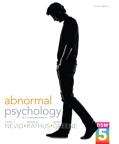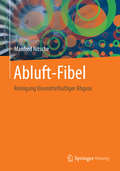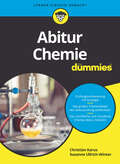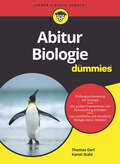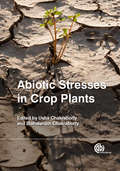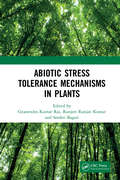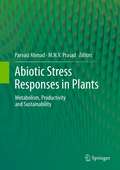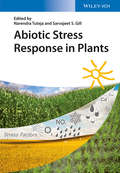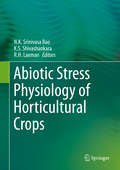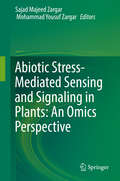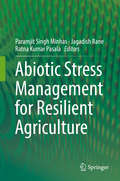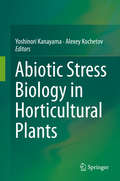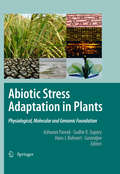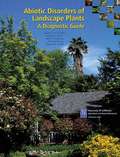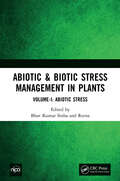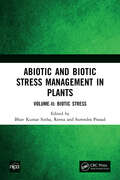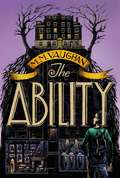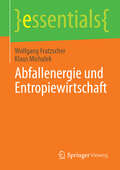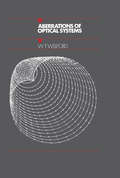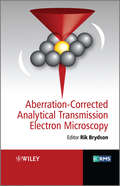- Table View
- List View
Abnormal Psychology in a Changing World
by Jeffrey S. Nevid Spence A. Rathus Beverly S. GreeneAbnormal Psychology in a Changing World, 9/e uses first-person narratives from people struggling with psychological disorders as a pedagogical framework. Updated to reflect the revision of the Diagnostic and Statistical Manual (DSM-5), the authors endeavor to bring research developments and advancements in abnormal psychology to students. Through illustrative case examples drawn from the authors' own experiences, they recognize there is a human dimension to the study of abnormal psychology.
Abnormal Psychology (Eighth Edition)
by Ronald J. ComerAn inspiring and clearly written graduate textbook with psychology concepts explained in a way easy to comprehend with updates on DSM-5.
Abnormal Psychology (12th Edition)
by Gerald C. Davison Sheri Johnson John M. Neale Ann M. KringAbnormal Psychology 12th Edition, continues the tradition of giving students the opportunity to explore the latest theories and research in the field. It has been adapted to take into account UK/European examples in diagnosis and classifcation of mental illness, statistics on misuse of drugs and treatment as well as a fully revised chapter with European examples on legal and ethical issues. As distinguished scholars and leaders in the field of Psychology, our author team continues to emphasize recent and comprehensive research coverage that has been the hallmark of the text. Significant new material correlated to the forthcoming Diagnostic and Statistical Manual of Mental Disorders 5 (DSM-5), included in every chapter. Abnormal Psychology emphasizes an integrated approach, showing how psychopathology is best understood by considering multiple perspectives, and how these varying perspectives can provide us with the clearest accounting of the causes of these disorders as well as the best possible treatments. Created for the 11th edition, we continue to offer a powerful video series for your Abnormal Psychology course with 7-10 minute clips to show in class or for students to review outside of class to help understand the patients experience. Unlike other videos, these feature real patients' and their families, in the context of their lives, describing symptoms from their own perspective. Each video provides concise information about the available treatment options.
Abluft-Fibel: Reinigung lösemittelhaltiger Abgase
by Manfred NitscheDieses Fachbuch beschreibt welches Verfahren zur Abluftreinigung f#65533;r Sie das Richtige ist. Zun#65533;chst wird die indirekte und direkte Kondensation, sowie die Membrananreicherung mit Kondensation erl#65533;utert. Die weiteren Kapitel besch#65533;ftigen sich mit der Absorption der L#65533;semittel in geeigneten Waschfl#65533;ssigkeiten, der Regeneration des Waschmittels und geben Auskunft #65533;ber Adsorptionsverfahren mit Dampf,- Inertgas-, und Vakuumdesorption. Der abschlie#65533;ende Beitrag behandelt die thermische und biologische Entsorgung.
Ablaze: The Story of Chernobyl
by Piers Paul ReadA riveting account of the chilling precursors and deadly aftermath of the 1986 Soviet nuclear disaster from the bestselling author of Alive. This highly readable and deeply researched exposé draws upon unclassified data from the former Soviet Union and a wealth of firsthand interviews to give a complex and human account of one of the worst nuclear catastrophes in history. Starting in 1942, when a young Russian physicist named Georgi Flerov warned Stalin that the Americans were building an atomic bomb, author Piers Paul Read recounts the birth and growth of atomic energy in the USSR--and the construction of the V. I. Lenin Nuclear Power Station at Chernobyl. Embedded in this story are the KGB cover-ups, power grabs, safety oversights, and risky decisions that set the stage for the explosion of the station's fourth reactor on April 26, 1986. According to Soviet authorities, only thirty-one people lost their lives due to the Chernobyl disaster, but its consequences were far too big for even the Kremlin to sweep under the rug--though the authorities certainly tried. Radiation burns and nuclear debris could not be concealed, and the cloud of radioactive material spewing from the damaged reactor was monitored throughout Europe. In the areas most immediately affected, there was a leap in the incidence of thyroid cancer. Moment by moment, Read takes us through the chaos and horror of the meltdown, and voice by voice, he records the stories that reveal the lasting repercussions of that day. Set in a regime where demotion was considered a fate worse than death and silence had the power to kill, Ablaze tackles the social and technological chain reactions that wreaked havoc not only on the USSR's power supply but on the strength and stability of the nation. It is a must-read for anyone interested in Soviet-era history or the promises and perils of nuclear power.
Abitur Chemie für Dummies (Für Dummies)
by Christian Karus Susanne Ullrich-WinterDas Chemie Abi steht an und es ist vielleicht auch gar nicht mehr so viel Zeit? Keine Panik, dieses Buch hilft Ihnen. Christian Karus und Susanne Ullrich-Winter erklären Ihnen, was Sie über Physikalische Chemie, Organische Chemie, Donator-Akzeptor-Prinzip und vieles mehr wissen sollten. Aber nicht nur das: Sie führen auch die Grundlagen an, die Sie aus den vorangegangenen Schuljahren mitbringen sollten. Außerdem erhalten Sie umfangreiche Tipps rund um die Abiturprüfung. So hilft Ihnen dieses Buch sowohl als Begleiter in der Oberstufe als auch konkret bei der Vorbereitung zum Abitur.
Abitur Biologie für Dummies (Für Dummies)
by Thomas Gerl Karen StahlWie sieht die ideale Abiturvorbereitung aus? Lernen müssen Sie schon selbst, aber dieses Buch in leicht verständlicher Sprache macht das Lernen nachhaltig. Vertiefen Sie sich in die Stoffwechselphysiologie der Zelle, verstehen Sie die Genetik, erfahren Sie, was Evolution, Verhalten und Ökologie miteinander zu tun haben. Das letzte große Thema, die neuronale Informationsverarbeitung schaffen Sie auch noch. Damit der Stoff besser im Kopf bleibt, werden immer wieder Verbindungen zum Alltag gezeigt, Aufgaben eingestreut und besonders spannende Fakten hervorgehoben. Die wichtigen Themen aller Bundesländer sind berücksichtigt. So kann der große Tag der Prüfung kommen.
Abiotic Stresses in Crop Plants
by Usha Chakraborty Bishwanath ChakrabortyBased on the biochemical and molecular mechanisms of tolerance of commonly encountered abiotic stresses in nature, this book covers the effect of increasing temperature, flood, drought, salinity, ozone and heavy metals such as arsenic and cadmium on plants. It discusses how these abiotic stresses can be managed in a cost-effective and eco-friendly way by utilising the alleviating mechanisms of microbes. Written in three sections, it considers each stress and their alleviation methods in detail, providing a rounded and vital resource on the subject for researchers and students of crop stress, management and biology.
Abiotic Stress Tolerance Mechanisms in Plants
by Gyanendra Kumar Rai; Ranjeet Ranjan Kumar; Sreshti BagatiSince recent years, the population across the globe is increasing expeditiously; hence increasing the agricultural productivity to meet the food demands of the thriving population becomes a challenging task. Abiotic stresses pose as a major threat to agricultural productivity. Having an adequate knowledge and apprehension of the physiology and molecular biology of stress tolerance in plants is a prerequisite for counteracting the adverse effect of such stresses to a wider range. This book deals with the responses and tolerance mechanisms of plants towards various abiotic stresses. The advent of molecular biology and biotechnology has shifted the interest of researchers towards unraveling the genes involved in stress tolerance. More effort is being made to understand and pave ways for developing stress tolerance mechanisms in crop plants. Several technologies including Microarray technology, functional genomics, on gel and off gel proteomic approaches have proved to be of utmost importance by helping the physiologists, molecular biologists and biotechnologists in identifying and exploiting various stress tolerance genes and factors for enhancing stress tolerance in plants. This book would serve as an exemplary source of scientific information pertaining to abiotic stress responses and tolerance mechanisms towards various abiotic stresses.Note: T&F does not sell or distribute the Hardback in India, Pakistan, Nepal, Bhutan, Bangladesh and Sri Lanka.
Abiotic Stress Responses in Plants: Metabolism, Productivity and Sustainability
by Parvaiz Ahmad M.N.V. PrasadAbiotic stress cause changes in soil-plant-atmosphere continuum and is responsible for reduced yield in several major crops. Therefore, the subject of abiotic stress response in plants - metabolism, productivity and sustainability - is gaining considerable significance in the contemporary world. Abiotic stress is an integral part of "climate change," a complex phenomenon with a wide range of unpredictable impacts on the environment. Prolonged exposure to these abiotic stresses results in altered metabolism and damage to biomolecules. Plants evolve defense mechanisms to tolerate these stresses by upregulation of osmolytes, osmoprotectants, and enzymatic and non-enzymatic antioxidants, etc. This volume deals with abiotic stress-induced morphological and anatomical changes, abberations in metabolism, strategies and approaches to increase salt tolerance, managing the drought stress, sustainable fruit production and postharvest stress treatments, role of glutathione reductase, flavonoids as antioxidants in plants, the role of salicylic acid and trehalose in plants, stress-induced flowering. The role of soil organic matter in mineral nutrition and fatty acid profile in response to heavy metal stress are also dealt with. Proteomic markers for oxidative stress as a new tools for reactive oxygen species and photosynthesis research, abscisic acid signaling in plants are covered with chosen examples. Stress responsive genes and gene products including expressed proteins that are implicated in conferring tolerance to the plant are presented. Thus, this volume would provides the reader with a wide spectrum of information including key references and with a large number of illustrations and tables.
Abiotic Stress Response in Plants
by Sarvajeet S. Gill Narendra TutejaUnderstanding abiotic stress responses in plants is critical for the development of new varieties of crops, which are better adapted to harsh climate conditions. The new book by the well-known editor team Narendra Tuteja and Sarvajeet Gill provides a comprehensive overview on the molecular basis of plant responses to external stress like drought or heavy metals, to aid in the engineering of stress resistant crops. After a general introduction into the topic, the following sections deal with specific signaling pathways mediating plant stress response. The last part covers translational plant physiology, describing several examples of the development of more stress-resistant crop varieties.
Abiotic Stress Physiology of Horticultural Crops
by N.K. Srinivasa Rao K. S. Shivashankara R. H. LaxmanThis book brings together recent advances in the area of abiotic stress tolerance in various vegetables, fruit crops, plantation crops and tuber crops. The main challenges to improving the productivity of horticultural crops are the different types of abiotic stresses generally caused by climate change at the regional and global level. Heat, drought, cold and salinity are the major abiotic stresses that adversely affect growth and productivity and can trigger a series of morphological, physiological, biochemical and molecular changes in various horticultural crops. To date, there are no books covering horticultural crop-specific abiotic stress tolerance mechanisms and their management. Addressing that gap, the book is divided into 2 sections, the first of which highlights recent advances in the general aspects of abiotic stress tolerance like the role of hormones, reactive oxygen species, seed treatments, molecular mechanisms of heat tolerance and heavy metal toxicity, while the second focuses on the abiotic stress tolerance mechanisms of various vegetables, fruit crops, plantation crops and tuber crops. It includes comprehensive discussions of fruit crops like mango, grapes, banana, litchi and arid zone fruits; vegetables crops like tomato, capsicum, onion and tuber crops; and plantation crops like coconut, areca nut, oil palm and black pepper. Among the strategies for plant stress survival, examples of both avoidance and tolerance relevant to particular crops are examined in detail, supported by selected comprehensive case studies of progress. As such, the book offers a valuable resource suited for scientists and graduate students working in the fields of crop improvement, genetic engineering, and the abiotic stress tolerance of horticultural crops.
Abiotic Stress-Mediated Sensing and Signaling in Plants: An Omics Perspective
by Sajad Majeed Zargar Mohammad Yousuf Zargar<P>The natural environment for plants is composed of a complex set of abiotic and biotic stresses; plant responses to these stresses are equally complex. Systems biology allows us to identify regulatory hubs in complex networks. It also examines the molecular “parts” (transcripts, proteins and metabolites) of an organism and attempts to combine them into functional networks or models that effectively describe and predict the dynamic activities of that organism in different environments. <P>This book focuses on research advances regarding plant responses to abiotic stresses, from the physiological level to the molecular level. It highlights new insights gained from the integration of omics datasets and identifies remaining gaps in our knowledge, outlining additional focus areas for future crop improvement research. <P>Plants have evolved a wide range of mechanisms for coping with various abiotic stresses. In many crop plants, the molecular mechanisms involved in a single type of stress tolerance have since been identified; however, in order to arrive at a holistic understanding of major and common events concerning abiotic stresses, the signaling pathways involved must also be elucidated. To date several molecules, like transcription factors and kinases, have been identified as promising candidates that are involved in crosstalk between stress signalling pathways. However, there is a need to better understand the tolerance mechanisms for different abiotic stresses by thoroughly grasping the signalling and sensing mechanisms involved. <P>Accordingly, this book covers a range of topics, including the impacts of different abiotic stresses on plants, the molecular mechanisms leading to tolerance for different abiotic stresses, signaling cascades revealing cross-talk among various abiotic stresses, and elucidation of major candidate molecules that may provide abiotic stress tolerance in plants.
Abiotic Stress Management for Resilient Agriculture
by Paramjit Singh Minhas Jagadish Rane Ratna Kumar PasalaThis book offers a state-of-the-art overview of on abiotic stresses in terms of the challenges; scope and opportunities; copping strategies for adaptation and mitigation using novel tools for building resilience in agricultural crops and livestock; as well as for policy implementation. Divided into four major parts: advances and prospects for understanding stress environments; adaptation and mitigation options; crop-based mitigation strategies; and mitigation options in animal husbandry, the book focuses on problem-solving approaches and techniques that are essential for the medium to long-term sustainability of agricultural production systems The synthesis and integration of knowledge and experiences of specialists from different disciplines offers new perspectives in the versatile field of abiotic stress management, and as such is useful for various stakeholders, including agricultural students, scientists, environmentalists, policymakers, and social scientists.
Abiotic Stress Biology in Horticultural Plants
by Yoshinori Kanayama Alexey KochetovThe purpose of this publication is to elucidate the biological aspect of the abiotic stress response from the field to the molecular level in horticultural plants. This book is unique in that it concerns the basic aspect of abiotic stress biology and research progress at the molecular level in model plants or major field crops, as it focuses mainly on the abiotic stress response in existing horticultural plants. Many readers interested in plant abiotic stress biology are aware of the application of the latest findings to agricultural production, and this book will have a special appeal for those readers. The book will be of interest to scientists and graduate students who are involved in the research, development, production, processing, and marketing of horticultural products, including those in developing countries who are interested in high tech and advanced science in this field. The application of the latest findings to agricultural production is particularly useful. Stress tolerance mechanisms in horticultural crops are gaining importance, because most agricultural regions are predicted to experience considerably more extreme environmental fluctuations due to global climate change. Further, because of recent progress in next-generation sequencing technologies, the postgenomic era is impending not only in model plants and major cereal crops but also in horticultural crops, which comprise a great diversity of species. This book provides information on the physiological aspects of the abiotic stress response in horticultural plants, which is considered essential for postgenomic research.
Abiotic Stress Adaptation in Plants: Physiological, Molecular and Genomic Foundation
by Hans J. Bohnert Ashwani Pareek Govindjee S. K. SoporyEnvironmental insults such as extremes of temperature, extremes of water status as well as deteriorating soil conditions pose major threats to agriculture and food security. Employing contemporary tools and techniques from all branches of science, attempts are being made worldwide to understand how plants respond to abiotic stresses with the aim to help manipulate plant performance that will be better suited to withstand these stresses. This book on abiotic stress attempts to search for possible answers to several basic questions related to plant responses towards abiotic stresses. Presented in this book is a holistic view of the general principles of stress perception, signal transduction and regulation of gene expression. Further, chapters analyze not only model systems but extrapolate interpretations obtained from models to crops. Lastly, discusses how stress-tolerant crop or model plants have been or are being raised through plant breeding and genetic engineering approaches. Twenty three chapters, written by international authorities, integrate molecular details with overall plant structure and physiology, in a text-book style, including key references.
Abiotic Disorders of Landscape Plants: A Diagnostic Guide
by Laurence R. Costello Edward J. Perry Nelda P. Matheny J. Michael Henry Pamela M. GeiselLandscape plants can be injured by biotic and abiotic agents. This book focuses on abiotic disorders such as water deficits, aeration deficits, nutritional deficiencies, specific ion toxicities, pH-related problems, and herbicide injury.
Abiotic & Biotic Stress Management in Plants: Volume-I: Abiotic Stress
by Bhav Kumar Sinha ReenaThis book deals with an array of topics in the broad area of abiotic stress responses in plants focusing “problems and their management” by selecting some of the widely investigated themes. Such as, Cell signalling in Plants during abiotic and biotic stress, Salinity stress induced metabolic changes and its management, High temperature stress: responses, mechanism and management, Low temperature stress induced changes in plants and their management, Biotechnological approaches to improve abiotic stress tolerance, Nutritional poverty in wheat under abiotic stress scenario, Strategies for improving soil health under current climate change scenario, Abiotic stress management in Pulse crops, Mitigation strategies of abiotic stress in fruit crops, Impacts of abiotic stress and possible management option in vegetable crops, and Abiotic stress: impact and management in ornamental crops. This book is useful for under-graduate and post-graduate students in Plant Physiology, Biochemistry, agronomy, horticulture, Botany, Environmental sciences and other cognate disciplines of agriculture and allied sciences and other research workers. We fervently believe that this book will provide good information and understanding of abiotic stress problems and their management in plants.Note: T& F does not sell or distribute the Hardback in India, Pakistan, Nepal, Bhutan, Bangladesh and Sri Lanka. This title is co-published with NIPA.
Abiotic and Biotic Stress Management in Plants: Volume-II: Biotic Stress
by Bhav Kumar SinhaThis book deals with an array of topics in the broad area of biotic stress responses in plants focusing “problems and their management” by selecting some of the widely investigated themes. Such as, Major insect-pest of cereal crops in India and their management, Biotic stresses of major pulse crops and their management strategies, Insect pest of oilseed crops and their management, Biotic stresses of vegetable crops & their management, Insect pests infesting major vegetable crops and their management strategies, Fruit Crops Insect pests and their Biointensive Integrated Pest Management techniques, Mass Trapping of fruit flies using Methyl Eugenol based Traps, Organic means of combating biotic stresses in plants, Nematode problem in pulses and their management, and approaches in pest management of stored grain pests. This book is useful for under-graduate and post-graduate students in Entomology, Plant Pathology, Agronomy, Horticulture, other cognate disciplines of agriculture and allied sciences and other research workers. Note: T& F does not sell or distribute the Hardback in India, Pakistan, Nepal, Bhutan, Bangladesh and Sri Lanka. This title is co-published with NIPA.
The Ability
by Iacopo Bruno M. M. VaughanDelve into the extraordinary abilities of the twelve-year-old mind in this thrilling start to a middle-grade series that expands the possibilities of power.No one has any confidence in twelve-year-old Christopher Lane. His teachers discount him as a liar and a thief, and his mom doesn't have the energy to deal with him. But a mysterious visit from the Ministry of Education indicates that Chris might have some potential after all: He is invited to attend the prestigious Myers Holt Academy. When Christopher begins at his new school, he is astounded at what he can do. It seems that age twelve is a special time for the human brain, which is capable of remarkable feats--as also evidenced by Chris's peers Ernest and Mortimer Genver, who, at the direction of their vengeful and manipulative mother, are testing the boundaries of the human mind. But all this experimentation has consequences, and Chris soon finds himself forced to face them--or his new life will be over before it can begin.
The Ability
by M. M. Vaughan Iacopo BrunoDelve into the extraordinary abilities of the twelve-year-old mind in this "fast-paced, superhero-tinged spy novel" (Publishers Weekly), the thrilling start to a middle grade series that expands the possibilities of power.No one has any confidence in twelve-year-old Christopher Lane. His teachers discount him as a liar and a thief, and his mom doesn't have the energy to deal with him. But a mysterious visit from the Ministry of Education indicates that Chris might have some potential after all: He is invited to attend the prestigious Myers Holt Academy. When Christopher begins at his new school, he is astounded at what he can do. It seems that age twelve is a special time for the human brain, which is capable of remarkable feats--as also evidenced by Chris's peers Ernest and Mortimer Genver, who, at the direction of their vengeful and manipulative mother, are testing the boundaries of the human mind. But all this experimentation has consequences, and Chris soon finds himself forced to face them--or his new life will be over before it can begin.
Abfallwirtschaft: Handbuch für Praxis und Lehre
by Bernd Bilitewski Georg HärdtleIn bewährter Weise beantwortet dieses Standardwerk alle Fragen der täglichen Praxis zum Thema Abfall. Für die Neuauflage haben die Autoren das gesamte Werk auf den neuesten Stand gebracht: die rechtlichen Grundlagen, Angaben zu Abfallmengen und -zusammensetzung, zur Sammlung, zum Umschlag und Transport, zu Recycling und Kosten von Abfallbehandlungsanlagen wurden aktualisiert. Außerdem wurde der Band um eine Zusammenfassung der aktuellen Entwicklungen im Bereich Stoffstrommanagement und um das Thema automatische Sortierung erweitert.
Abfallenergie und Entropiewirtschaft (essentials)
by Wolfgang Fratzscher Klaus MichalekEs wird eine allgemein gültige Definition der Abfallenergie vorgeschlagen. Diese erfordert die Einbeziehung des II. Hauptsatzes der Thermodynamik. Das Auftreten von inneren Nichtumkehrbarkeiten bei allen technischen Prozessen als wesentliche, in den Energiebilanzen nicht sichtbare Verlustquellen führt zu äußeren Verlusten, den Abfallenergien. Die betrachteten Systeme zeigen den Einfluss von Technologie und Bilanzgrenzen auf Art und Größe der Verluste und den Zusammenhang zwischen Primärenergiebilanz, anthropogenen Prozessen und Abfallenergie. So stellt sich die Abfallenergieverwertung als die duale Seite einer allgemeinen energiewirtschaftlichen Betrachtung dar. Wenn man von einem solchen Ansatzpunkt ausgeht, spricht man nach einem Paradigmenwechsel bei der Gestaltung optimaler technischer Prozesse von einer Entropiewirtschaft statt einer Energiewirtschaft.
Aberrations of Optical Systems
by W.T WelfordAlthough the subject of optical design as a branch of applied physics is over one hundred years old, the use of aberration theory has changed considerably. Aberrations of Optical Systems covers elementary optics and aberration theory of various optical systems, including the use of nonaxially symmetric systems and diffractive optical elements in complex designs, such as head-up displays and the increasing use of scanning systems with laser illumination. The book provides the complete range of mathematical tools, formulae, and derivations needed for understanding the process of optical design and for planning optical design programs. While the treatment is mainly based on geometrical optics, some excursions into physical optics are made, particularly in connection with the problems of optical tolerances.
Aberration-corrected Analytical Electron Microscopy
by Rik BrydsonThe book is concerned with the theory, background, and practical use of transmission electron microscopes with lens correctors that can correct the effects of spherical aberration. The book also covers a comparison with aberration correction in the TEM and applications of analytical aberration corrected STEM in materials science and biology. This book is essential for microscopists involved in nanoscale and materials microanalysis especially those using scanning transmission electron microscopy, and related analytical techniques such as electron diffraction x-ray spectrometry (EDXS) and electron energy loss spectroscopy (EELS).
